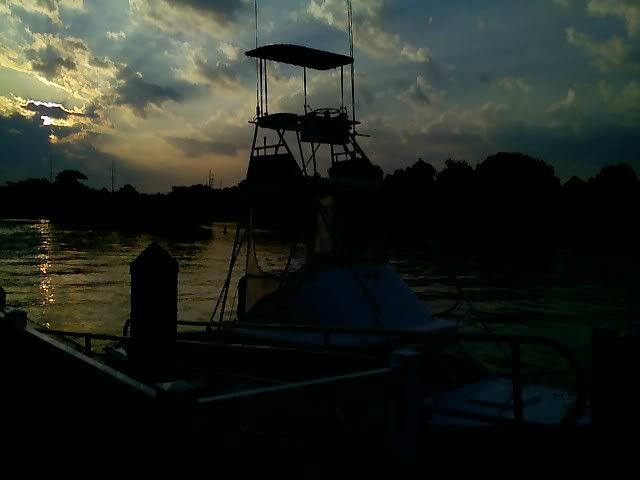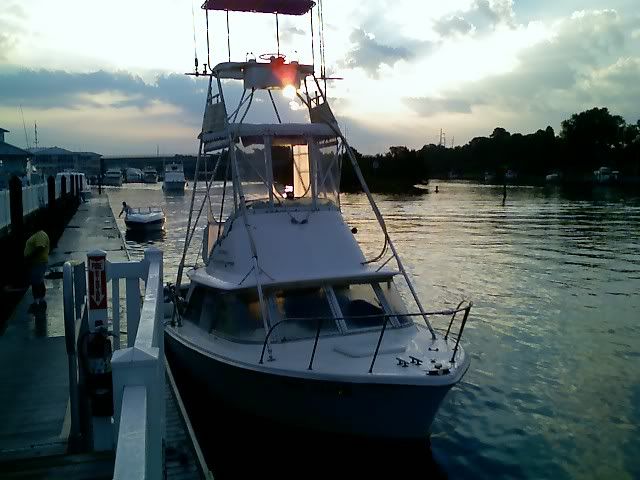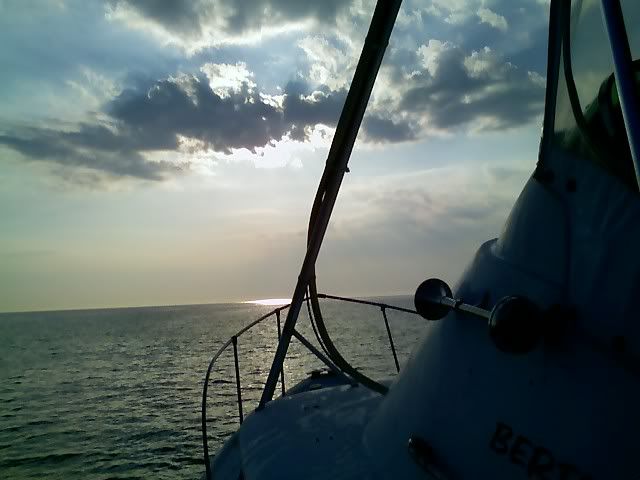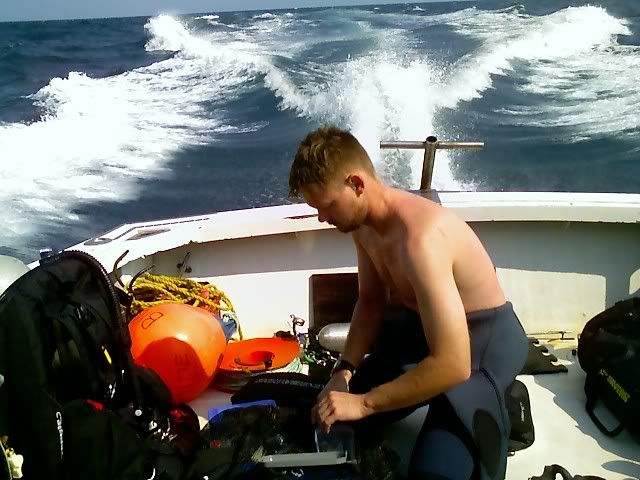Hi All:
Well, I had originally planned to dive the U-701 last weekend, but the charter was short divers so we couldnt go. I scrambled to find a worthwhile local dive, but again came up short on Saturday. At the last minute Dive Quarters put together a Sunday dive to the Kurn, a wreck I didnt know and hadnt dived before.
My day started at 06:30 AM, meeting Captain Steve, owner/operator of the Big Time, a 31 FT Bertram 6-pack charter used by Dive Quarters, at the Marina Shores dock off Great Neck Rd. for loading. With only 4 divers and Matt, a Dive Quarters shop instructor and DM, the loading went quick and we were soon underway. Captain Steve takes care of his customers and he briefly stopped at a dock store for coffee, ice and food on the way out. 15 minutes later we cleared the Lynnhaven Inlet bridge and were making 20 KTS to the location of the wreck, 30 NM E/NE of Cape Henry.


Although locally known as a Navy sponsored artificial reef, I could find no reference to the Kurn in Navy or Virginia Marine Resource Commission documentation. Its also not in any of the popular books on east coast diving. At the time of writing this, Ive been conversing with a contact at VMRC and he CANT find any reference to the Kurn as an artificial project either (does anyone have any information?). Even an Internet search returns limited hits, all local. These same local sources identify it as an ocean going tug, but others state its a small tanker. But, regardless of what it was, we were on the way to it! The weather was outstanding, a gorgeous fall day with flat and glassy seas all the way to the wreck.

We arrived on site and were hooked up by 10:00 AM. We then took a few minutes to work out the diving arrangements. Bobby, my regular buddy, was diving in Italy (the bum), so that left me solo. Two guys from NOVA were diving together and the other diver was Matts AOW student. Matt and I discussed my plan and run times, I was planning 30 to 40 minute BTs with light deco. I opted to dive my Viking DS with a single 121 LP, H valves and a slung 40 for deco. Back gas was 32 EAN with 50/50 deco. RTs for each dive would not exceed 60 minutes even with +4 safety factor using V-Planner.
The surface conditions were so good that Steve hooked the boat off the stern, allowing Matt to drop in and swim straight down to tie the hook. Although the sea did not look promising, you cant always judge a book by its cover. Ive seen blue water and 100 FT+ of surface visibility off Virginia Beach, only to be disappointed by less than 10 FT of bottom visibility. When I jumped in and descended, visibility on the anchor line was less than 5 FT but at 60 FT the fuzz suddenly cleared and bottom viz extended to 30 FT. Bottom temps were in the 60s. Matt had hooked the stern of the wreck and tied in near an open deck hatch. I soon realized that I was looking at the rear section of what appeared to be an ocean going tug with a 30 FT beam. It sits upright buried in the 95 FT sandy bottom to the shaft struts, with no rudders or props visible. The deck at 80 FT is open and uncluttered, except at the separation point between the bow and stern. An open hatch allowed easy penetration of the stern with a swim-through to the exposed end. I saw few interior obstructions when I entered, but silt was a factor so good buoyancy and minimal finning were required.
The stern section ends in a jumble of plates, pipes, fixtures and other materials where it had been violently separated from the bow. If this ship was an artificial placement, someone used a be-Jesus batch of explosives to send her to the bottom the old fashioned way, by literally blowing the ship up and breaking her back. I explored the broken end and did a once around of the entire stern section, all the way to the sand. Some debris extended outward from the broken end of the stern and I jump reeled outward to see if I could find the bow. Swimming into a bottom current for 10 minutes produced no results, so I turned and made it back to the stern where I tied off my reel and left it for the second dive. A few minutes later I was on the way up and after a short deco I surfaced to find the Big Time bouncing somewhat in rougher seas. In less than an hour, the Atlantic had gone from lake conditions to small whitecaps on 2 FT waves. Needless to say, Steve switched the anchor line from stern to bow and we swung around into the 10 KT NE wind. Lunch followed with a one hour SIT.
Everyone chose to make the second dive, even with the rougher conditions. The two NOVA divers decided to look for the bow section off the right side of the stern. They went in first. I went second and noticed that the surface current had picked up. Getting down the anchor line was a little more difficult, but I made it without too much trouble. Shortly after, I found the hook and followed the stern around to where my reel was tied in. This time I jumped left swimming hard into a bottom current across a flat sandy area with some debris. Looking ahead, I couldnt really see anything but I swore I could see a darker shadow in the distance. Suddenly, a school of BIG amberjack swirled around me, 30 or more curious fish coming within arms reach to check me out. One of the jacks was obviously shaped funny on the bottom side a large semi-circular area was missing from the tail (hmmm ) which did not appear to detract from his smooth swimming ability (lucky fish!). Distracted by the jacks, I missed the appearance of the bow section that loomed upward directly ahead of me.
Wow, I was there! The bow section was HUGE, turned upside down with the intact hull extending away and upward from the broken end. Like the stern, the broken end was a mass of plates, pipes, fixtures and other stuff that attested to the violence of the ships sinking. Again, I thought about how much force was used to break this large ship in two. I tied in on a pipe, with only a few feet of reel line remaining. Id estimate the separation between the bow and stern sections is less than 175 FT, given how much line I had used in the jump between sections. I began swimming toward the front of the bow at the level of the sand on the right side, actually the portside of the upside down ship. Again, masses of wreckage greeted me, the bottom near the side of the ship was just littered with junk. About 75 FT into my swim, I saw a large dark hole leading under the wreck. Peering in, I could see penetrable space extending all under the wreck with about 7 FT of overhead clearance. Dim sunlight could be seen streaming in from the other side. Slightly forward of this hole, another smaller opening could also be seen. The interior space appeared to have moderate overhead obstructions, including pipes and cables hanging from the ceiling. I also realized that the engineering space would be overhead of this section, meaning the engines (if still installed) would be hanging above me. Although tempted, I had no reel or buddy, so an interior penetration would have to wait until my next visit.
Continuing my swim forward, I eventually arrived at the knife edge of the bow and it was an impressive sight. Washed out in the sand, the bow extends downward to about 105 FT, with the bottom of the hull (keel end of the upside down wreck) at 75 FT. What appeared to be an anchor chain (key sign of an artificial placement) extended outward to the right embedded in the sand. Freely floating in front of the bow at about 90 FT, I experienced one of those magical moments in diving that come so rarely. Sunlight broke downward from the surface, illuminating the hull completely. On my right, a large school of baitfish appeared and flashed silver as I pointed my light toward them. They moved in a ball, collapsing inward as the school of amberjack suddenly returned whirling around me and upward, only a few feet away. The water around me was crowded with life, impressing on me that shipwrecks are actually living reefs and an important part of the ecosystem. I hung there for 30 seconds, enjoying the spectacle until the fish moved off. Moments like this REALLY make diving off Virginia enjoyable.
Checking my timer, I noticed that my planned BT was rapidly ending. I estimated the length of the bow section at about 200 FT and because I needed to find my reel, I didnt return along the opposite side of the wreck that I hadnt seen yet. Like the interior, Ill save that for my next visit. Extending my arms, legs and fins I increased body profile to the current running down the hull and was soon flying toward the broken end of the bow section. Exhaling completely I dropped downward to my reel tie and was soon jumping back to the stern section of the wreck reeling in line. I arrived at the anchor a few minutes later and started my ascent just shy of 40 minutes. By the time I reached my 20 FT stop, it was obvious surface conditions had changed. Captain Steve had increased the scope of the hook, meaning the anchor line was now much more horizontal than previously. By 10 FT the line was jerking violently up and down so I tied in my Jon line to complete deco more comfortably. 15 minutes later I surfaced in 4 FT seas with whitecaps and a strong surface current. The boarding ladder was a little challenging, but I made it aboard without breaking anything. Matt jumped in to retrieve the hook and I went forward to pull it up. We picked up Matt after he completed a drifting stop using his SMB and soon were headed toward home.


Although the ride back was wetter, Steves Bertram 31 has awesome legs for a six-pack boat. Even in 3 to 5 FT waves, it was comfortable. We made the dock by 04:00 PM and our day of diving on the Kurn was regrettably over. Taking time to reflect on the trip, Id have to say both the wreck and the diving were OUTSTANDING. In fact, it was a Top 5 for this season!
Anyone game for another trip?
Well, I had originally planned to dive the U-701 last weekend, but the charter was short divers so we couldnt go. I scrambled to find a worthwhile local dive, but again came up short on Saturday. At the last minute Dive Quarters put together a Sunday dive to the Kurn, a wreck I didnt know and hadnt dived before.
My day started at 06:30 AM, meeting Captain Steve, owner/operator of the Big Time, a 31 FT Bertram 6-pack charter used by Dive Quarters, at the Marina Shores dock off Great Neck Rd. for loading. With only 4 divers and Matt, a Dive Quarters shop instructor and DM, the loading went quick and we were soon underway. Captain Steve takes care of his customers and he briefly stopped at a dock store for coffee, ice and food on the way out. 15 minutes later we cleared the Lynnhaven Inlet bridge and were making 20 KTS to the location of the wreck, 30 NM E/NE of Cape Henry.


Although locally known as a Navy sponsored artificial reef, I could find no reference to the Kurn in Navy or Virginia Marine Resource Commission documentation. Its also not in any of the popular books on east coast diving. At the time of writing this, Ive been conversing with a contact at VMRC and he CANT find any reference to the Kurn as an artificial project either (does anyone have any information?). Even an Internet search returns limited hits, all local. These same local sources identify it as an ocean going tug, but others state its a small tanker. But, regardless of what it was, we were on the way to it! The weather was outstanding, a gorgeous fall day with flat and glassy seas all the way to the wreck.

We arrived on site and were hooked up by 10:00 AM. We then took a few minutes to work out the diving arrangements. Bobby, my regular buddy, was diving in Italy (the bum), so that left me solo. Two guys from NOVA were diving together and the other diver was Matts AOW student. Matt and I discussed my plan and run times, I was planning 30 to 40 minute BTs with light deco. I opted to dive my Viking DS with a single 121 LP, H valves and a slung 40 for deco. Back gas was 32 EAN with 50/50 deco. RTs for each dive would not exceed 60 minutes even with +4 safety factor using V-Planner.
The surface conditions were so good that Steve hooked the boat off the stern, allowing Matt to drop in and swim straight down to tie the hook. Although the sea did not look promising, you cant always judge a book by its cover. Ive seen blue water and 100 FT+ of surface visibility off Virginia Beach, only to be disappointed by less than 10 FT of bottom visibility. When I jumped in and descended, visibility on the anchor line was less than 5 FT but at 60 FT the fuzz suddenly cleared and bottom viz extended to 30 FT. Bottom temps were in the 60s. Matt had hooked the stern of the wreck and tied in near an open deck hatch. I soon realized that I was looking at the rear section of what appeared to be an ocean going tug with a 30 FT beam. It sits upright buried in the 95 FT sandy bottom to the shaft struts, with no rudders or props visible. The deck at 80 FT is open and uncluttered, except at the separation point between the bow and stern. An open hatch allowed easy penetration of the stern with a swim-through to the exposed end. I saw few interior obstructions when I entered, but silt was a factor so good buoyancy and minimal finning were required.
The stern section ends in a jumble of plates, pipes, fixtures and other materials where it had been violently separated from the bow. If this ship was an artificial placement, someone used a be-Jesus batch of explosives to send her to the bottom the old fashioned way, by literally blowing the ship up and breaking her back. I explored the broken end and did a once around of the entire stern section, all the way to the sand. Some debris extended outward from the broken end of the stern and I jump reeled outward to see if I could find the bow. Swimming into a bottom current for 10 minutes produced no results, so I turned and made it back to the stern where I tied off my reel and left it for the second dive. A few minutes later I was on the way up and after a short deco I surfaced to find the Big Time bouncing somewhat in rougher seas. In less than an hour, the Atlantic had gone from lake conditions to small whitecaps on 2 FT waves. Needless to say, Steve switched the anchor line from stern to bow and we swung around into the 10 KT NE wind. Lunch followed with a one hour SIT.
Everyone chose to make the second dive, even with the rougher conditions. The two NOVA divers decided to look for the bow section off the right side of the stern. They went in first. I went second and noticed that the surface current had picked up. Getting down the anchor line was a little more difficult, but I made it without too much trouble. Shortly after, I found the hook and followed the stern around to where my reel was tied in. This time I jumped left swimming hard into a bottom current across a flat sandy area with some debris. Looking ahead, I couldnt really see anything but I swore I could see a darker shadow in the distance. Suddenly, a school of BIG amberjack swirled around me, 30 or more curious fish coming within arms reach to check me out. One of the jacks was obviously shaped funny on the bottom side a large semi-circular area was missing from the tail (hmmm ) which did not appear to detract from his smooth swimming ability (lucky fish!). Distracted by the jacks, I missed the appearance of the bow section that loomed upward directly ahead of me.
Wow, I was there! The bow section was HUGE, turned upside down with the intact hull extending away and upward from the broken end. Like the stern, the broken end was a mass of plates, pipes, fixtures and other stuff that attested to the violence of the ships sinking. Again, I thought about how much force was used to break this large ship in two. I tied in on a pipe, with only a few feet of reel line remaining. Id estimate the separation between the bow and stern sections is less than 175 FT, given how much line I had used in the jump between sections. I began swimming toward the front of the bow at the level of the sand on the right side, actually the portside of the upside down ship. Again, masses of wreckage greeted me, the bottom near the side of the ship was just littered with junk. About 75 FT into my swim, I saw a large dark hole leading under the wreck. Peering in, I could see penetrable space extending all under the wreck with about 7 FT of overhead clearance. Dim sunlight could be seen streaming in from the other side. Slightly forward of this hole, another smaller opening could also be seen. The interior space appeared to have moderate overhead obstructions, including pipes and cables hanging from the ceiling. I also realized that the engineering space would be overhead of this section, meaning the engines (if still installed) would be hanging above me. Although tempted, I had no reel or buddy, so an interior penetration would have to wait until my next visit.
Continuing my swim forward, I eventually arrived at the knife edge of the bow and it was an impressive sight. Washed out in the sand, the bow extends downward to about 105 FT, with the bottom of the hull (keel end of the upside down wreck) at 75 FT. What appeared to be an anchor chain (key sign of an artificial placement) extended outward to the right embedded in the sand. Freely floating in front of the bow at about 90 FT, I experienced one of those magical moments in diving that come so rarely. Sunlight broke downward from the surface, illuminating the hull completely. On my right, a large school of baitfish appeared and flashed silver as I pointed my light toward them. They moved in a ball, collapsing inward as the school of amberjack suddenly returned whirling around me and upward, only a few feet away. The water around me was crowded with life, impressing on me that shipwrecks are actually living reefs and an important part of the ecosystem. I hung there for 30 seconds, enjoying the spectacle until the fish moved off. Moments like this REALLY make diving off Virginia enjoyable.
Checking my timer, I noticed that my planned BT was rapidly ending. I estimated the length of the bow section at about 200 FT and because I needed to find my reel, I didnt return along the opposite side of the wreck that I hadnt seen yet. Like the interior, Ill save that for my next visit. Extending my arms, legs and fins I increased body profile to the current running down the hull and was soon flying toward the broken end of the bow section. Exhaling completely I dropped downward to my reel tie and was soon jumping back to the stern section of the wreck reeling in line. I arrived at the anchor a few minutes later and started my ascent just shy of 40 minutes. By the time I reached my 20 FT stop, it was obvious surface conditions had changed. Captain Steve had increased the scope of the hook, meaning the anchor line was now much more horizontal than previously. By 10 FT the line was jerking violently up and down so I tied in my Jon line to complete deco more comfortably. 15 minutes later I surfaced in 4 FT seas with whitecaps and a strong surface current. The boarding ladder was a little challenging, but I made it aboard without breaking anything. Matt jumped in to retrieve the hook and I went forward to pull it up. We picked up Matt after he completed a drifting stop using his SMB and soon were headed toward home.


Although the ride back was wetter, Steves Bertram 31 has awesome legs for a six-pack boat. Even in 3 to 5 FT waves, it was comfortable. We made the dock by 04:00 PM and our day of diving on the Kurn was regrettably over. Taking time to reflect on the trip, Id have to say both the wreck and the diving were OUTSTANDING. In fact, it was a Top 5 for this season!
Anyone game for another trip?




